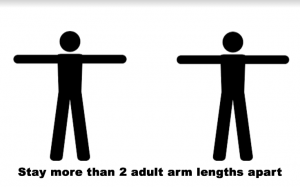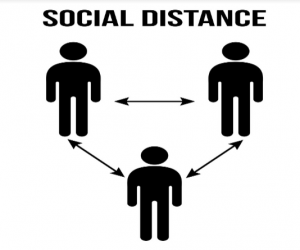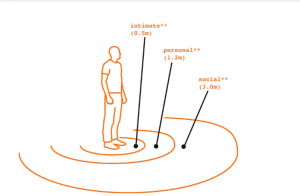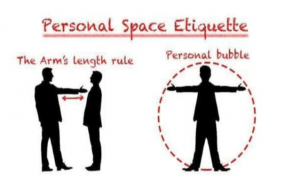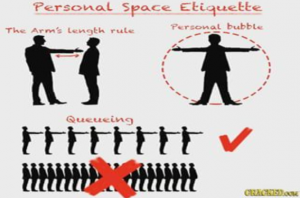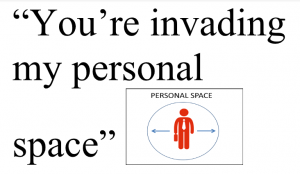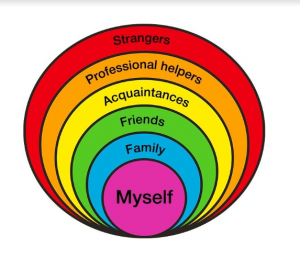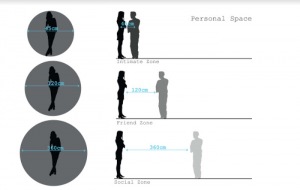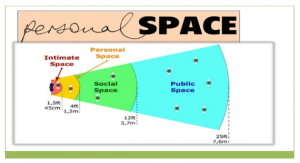Department of Foreign Languages presents a cycle of lessons on
Body Distance and Social Interaction
Within the topic Me in the World, we have prepared some interactive lectures to instill the norms of Social Interaction.
Body distance has always been important; however, in the light of recent events it has become even more actual. If you observe people talking you can see how they maintain a private space around themselves. Paying attention to how close someone stands to others during conversation is vital.
Have you ever been uncomfortable when someone stands too close?
Some people don’t seem to understand that putting their face inches from yours during a conversation can have you squirming and looking for the nearest exit.
That person has invaded your personal space. Most people have a certain distance they like to keep from others, depending on the relationship.
About Personal Space
The term “personal space” generally refers to the physical distance between two people in a social, family, or work environment. Think of your personal space as the air between your body and an invisible shield, or bubble, you have formed around yourself for any relationship.
The distance between you and your shield most likely varies from one person to another, depending on a variety of factors, including how well you know the person, your relationship to that person, how much you trust him or her, and your culture. In order to put others at ease, it’s important to understand the importance of personal space.
Determining Factors for Personal Space
The comfortable space between you and someone you know well will probably be much smaller than it would be if you barely knew the other person. With a stranger, it is even greater. Typically, people who live in crowded cities have smaller personal space preferences than those who live in wide-open spaces.
Other factors that determine a comfortable personal space:
• Male to male
• Female to female
• Male to female
• Professional relationship – any combination of male and female
• Romantic versus platonic relationship
• Culture and country
Average comfort levels of personal space distance in the U.S.:
• Approximately 0 to 20 inches for intimate couples
• Approximately 1-1/2 feet to 3 feet for good friends and family members
• Approximately 3 feet to 10 feet for casual acquaintances and coworkers
• More than 4 feet for strangers
• More than 12 feet for speaking to a large group
Invasion of Privacy
General Rules of Personal Space:
These rules vary according to culture and location, so they’re not etched in stone. They’re here as a guideline for social and professional etiquette.
Here are some basic rules:
1. Never touch anyone you don’t know.
2. Don’t reach for anyone else’s children, regardless of your intentions.
3. Stand at least 4 feet away from a person unless you know him or her well.
4. When someone leans away from you, you are probably in that person’s space that makes him or her uncomfortable. Take a step back.
5. If you walk into an auditorium or theater that isn’t crowded, leave an extra seat between you and the next person. However, it is acceptable to sit next to someone if the room is crowded.
6. Never lean over someone else’s shoulder to read something unless invited.
7. Never go through anyone else’s personal belongings.
8. Acknowledge personal space on the road. Don’t tailgate when driving.
9. Don’t fling your arm around someone’s shoulder or slap anyone on the back unless you know the person very well.
10. Don’t enter a room or office without knocking first.
11. Don’t cut in front of people in line.
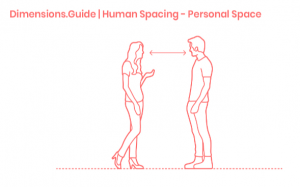
Լրահոս
- Դեկտեմբերի 8-ը Նկարչի միջազգային օր
- Interact with Biology
- ՀՀ կրթության,գիտության,մշակույթի և սպորտի նախարարության աջակցությամբ ու Հայաստանի պետական սիմֆոնիկ նվագախմբի նախաձեռնությամբ 2018թ. իրականացվում է «ԴասA» կրթական ծրագիրը։
- Scaffolding in Teaching
- Թարգմանչաց տոնի առթիվ X-6 տնտեսագիտական հոսքում համատեղ դասավանդում իրականացրին ուսուցիչներ Օ. Ղարիբյանը(Հայ գրականություն), Ա. Միրզոյանը ( Անգլերեն) և Ա. Խլղաթյանը ( Հայոց պատմություն)։
- Project -Based Learning Ideas in High School
- Դեկտեմբերի 1-ը ՁԻԱՀ-ի դեմ պայքարի համաշխարհային օրն է
- The Book of the Month
- Մանկավարժական ոլորտում փորձի փոխանակման միջոցառումների շնորհիվ անընդհատ կատարելագործվում է ուսուցչի նորարարական մոտեցումների կիրառումը ,ու լավագույն փորձը արագ տարածվում է։
- “Education is the passport to the future…”
- Բոլոր ժամանակներում ուսումնական բոլոր գործընթացներում կարևորվել են միջառարկայական կապերը, իսկ հանրակրթության նոր չափորոշիչներում դրանք արդեն պարտադիր պայման են
- Media Education in High School
- Youth engaged in Projects.
- Բարության օրը մի կաթիլ բարությամբ
- Создание армянских и славянских письмен.
- Երևանի Վալերի Բրյուսովի անվան օտար լեզուների համալսարանի ներկայացուցիչները դարձյալ դպրոցի հյուրերն էին
- Majoring in History
- Մշակութային ժառանությանը ծանոթանալը ժամանակի հրամայականն է ու Երևանի Կարեն Դեմիրճյանի անվան հ 139 ավագ դպրոցի պարտադիր պահանջներից մեկը.կրթօջախը ջանասիրաբար իրականացնում է այցեր թանգարաններ,պատկերասրահներ,գրադարաններ,թատրոններ։Դրանք չափազանց կարևոր են թե ազգային ինքնաճանաչողականության,թե մշակութային բազմազան միջավայրում ճանաչելիության առումով։
- Վարպետաց դաս 139-ում
- Pride as norm and vain glory as anomaly
- «Աշխարհացույց» կրթական հարթակը Երևանի Կ.Դեմիրճյանի 139 ավագ դպրոցում
- Երևանի հ 139-ի շրջանավարտներին
- My Home is my Castle.
- Отговорила роща золотая…
- Interdisciplinary learning.
- Երևանի Կարեն Դեմիրճյանի անվան հ 139 ավագ դպրոցում ծնողական խորհրդի ներգրավվածությունը միշտ էլ արժևորվել է.ծնողներին համատեղ գործունեության մեջ ներգրավելու փորձը ցույց է տվել,որ նույն կրթական միջավայրում փոխգործակցելով ՝ ավելի արդյունավետ է լուծվում սովորողների կրթման և սոցիալականացման խնդիրները։
- Вызовы и перспективы
- Համագործակցության ծիլեր
- Teenage problems and solutions
- Ярмарка проектов
- Դպրոցը կարդում է ու նկարում
- Երևանի Կարեն Դեմիրճյանի անվան հ 139 ավագ դպրոցի ֆիզմաթ հոսքի սաները Երևանի աստղացուցարանում՝ դիտելու տիեզերքի ծագումը,մոլորակների կազմավորումը,տիեզերագնացության զարգացումը։
- Understanding and responding to teenagers’ needs
- Norms VS Anomalies (WSP)
- Ամփոփիչ դաս՝ ուրարտագետի դիտարկումներով
- Международный день переводчика
- Կրթական Օսկարի հաղթողը
- Երևանի Կարեն Դեմիրճյանի անվան հ 139 ավագ դպրոցի
- Interact with History
- Մտքի փորձառությունն է օգնում դուրս գալ ծանր վիճակից ու դիմակայել ժողովրդին սպառնացող մարտահրավերներին։
- Սիրելի՜ նորնորքցիներ
- Նոր ուստարին նոր շենքում
- Ստեղծագործելով կորցնում ես սխալվելու վախը
- Հայրենիք,պատիվ,նվիրում.յուրաքանչյուր դեմիրճյանականի նշանաբանը
- Ավարտը՝ մեկնարկով
- Այս ժպիտի ու այս հմայքի մշտակայության մաղթանքներով….
- Բարի երթ ձեզ,սիրելի՜ շրջանավարտներ
- New Standards for General Education
- Армяно-российские отношения
- «ԲանՈւԳործ.ԵՊՀ էքսպո-2023»
- Գիտելիքով նվաճված հաղթանակ
- УРОК- КОНКУРС
- Բաց դռներ
- Խոնարհված ծաղիկներին նոր կյանք
- Մայրաքաղաքում ապրիլի 29-ը հայտարարվեց համաքաղաքային շաբաթօրյակ
- Նոր մեթոդներ , նոր մոտեցումներ՝ ձևափոխվող կրթության պահանջներին համահունչ։ 10-3/պատմական հոսք/ դասարանում կայացավ ամփոփիչ դաս՝,,Վահանանց պատերազմ,, թեմայով։
ՏՀՏ գործիքներից կիրառվեց ին Padlet, Power point,SmartArt ծրագրերը
Դասը անցկացվեց բացառապես գծապատկերների տեսքով,ապա անցկացվեց ,,Դերային խաղ,,, երբ պատմական կերպարները աշակերտների ներկայացմամբ
փորձում են լուծում տալ առաջ քաշված հիմնախնդրին,, Պայքար հայոց ինքնության պահպանման համար,,։
Խաչվող հասկացություններ՝պատճառ և առիթ, անհատ և հասարակություն, պատճառ և հետևանք։
ՀԳ Շնորհակալություն աշակերտներին՝ բարձր պատասխանատվություն դրսևորելու համար։
Ուսուցիչ՝ Կ․Գրիգորյան - Лермонтов «Мцыри»
В современном темпе жизни система образования претерпевает изменения. Внедряются новые методики и подходы к обучению, открываются информационно-образовательные пространства, которые позволяют развивать цифровую грамотность школьников, их творческую и проектную деятельность, а также их познавательную и социальную активность. Поэтому учителю тоже стоит обратить на это внимание при подготовке к урокам.
Проведение флешмоба решает большой спектр задач. Среди них:
• приобщение детей к книжной культуре, а также воспитание грамотного читателя;
• повышение эффективности работы по приобщению детей к книгам во взаимодействии всех участников образовательного процесса;
• обогащение словарного запаса детей,развитие грамматического строя речи;
• совершенствование коммуникативных навыков, активизация творческого потенциала у школьников;
• развитие формы воображения, в основе которой лежит интерпретация литературного образа.
На сей раз внимание учеников привлек главный герой поэмы Лермонтова «Мцыри». Чтобы лучше понять этот образ школьники в первую очередь обратились к истории создания произведения, которая могла бы сама по себе стать сюжетом для повести. Замысел написать поэму о юном монахе, погибающем в неволе монастыря, появляется у поэта еще в юности. В дневнике семнадцатилетнего Лермонтова мы находим следующие строки: «Написать записки молодого монаха 17-ти лет. С детства он в монастыре, кроме священных книг, ничего не читал. Страстная дума таится – Идеалы». Но понадобилось достаточно много времени, почти 10 лет, чтобы замысел поэта воплотился. Самым сложным оказалось найти те идеалы, за которые мог бы погибнуть герой.
Соединив услышанное от монаха со своими более ранними набросками, поэт создает окончательный вариант поэмы. Интересно, что он практически не изменил рассказ монаха, за исключением одной ключевой детали. Герой «Мцыри» не может смириться с монастырем, что является для поэта наиболее важным. Так рождается романтическое произведение «Мцыри».
Разумеется, какая бы история не лежала на самом деле в основании поэмы, потребовался огромный поэтический талант, чтобы превратить ее из простого рассказа о военных событиях в гениальную поэму. Создание «Мцыри» Лермонтова потребовало от него многих лет вдохновенного труда, а результат восхищает читателей и поныне. И это восхищение привело наших учащихся к мысли о флешмобе, дабы разделить свой восторг со слушателями.
10/1 класс
Учитель Егиазарян К.А. - Հաղթողի պատվանդանին
- Նոր համագործակցություն ու նոր հեռանկարներ
- Exam Mode Activated
- Երաժշտությունը ձևավորում է բնավորություն ու կամք,տարածական մտածողություն ու կարգապահություն,համբերություն ու հաղորդակցություն.ինչու՞ չմեկտեղել այս ամենը ու միաժամանակ չճաշակել բարձրաճաշակ երաժշտություն։
Երևանի Կարեն Դեմիրճյանի անվան հ 139 ավագ դպրոցի սաների ուսուցումը բազմակողմանի է ու կենդանի։ - Տիեզերքի թանգարանում
- Տիեզերագնացության օր
- Շնորհավոր ապրիլի 7
- Языковая политика и вопросы гуманитарного образования
- Where Time Begins
- Գիտության փառատոնի մշտական և փառավոր ներկայացուցիչ՝ Կ.Դեմիրճյանի անվան հ 139 ավագ դպրոց
- Հոգեբանի և ուսուցչի օգնականի աշխատանքային
- Interdisciplinary Project Ideas
- The Majesty and Grandeur of the English Language
- Ռազմահայրենասիրական դաստիարակությունը սկսվում է դպրոցից
- Dedicated to Women’s Day-The Galatea Effect
- Destination- Armenia
- Բաղադրյալ բառերը սև, սպիտակ, կապույտ, նարինջ, կանաչ, դեղին, կարմիր-(ն)երի խմբերում
- Teaching Logic and Sequencing through Narrative
- Բացի՜ր հոգուդ ներկապնակը,մա՜րդ,
- Hitting the Road
- Չարենցի կյանքի ոդիսականը
- “Save Natural resources” Whole school project
- Օրբելի եղբայրների տուն-թանգարանում
- Ածանցների ուսուցումը
- Հայրենասիրությունը գերագույն արժեք
- Տոնի վերածված դասամիջոց
- Similarities of Mother Tongue in Terms of Grammar and Language Structure
- Destination –Great Britain
- International Book Giving Day – February 14, 2023
- Teaching Productive Skills
- Ներկայումս կրթության հրատապ պահանջ է նախագծային աշխատանքների կազմակերպումն ու անցկացումը։
- Learning from recording video of your own classroom
- The Truth About Vitamins
- Shakespeare across Time, Languages, and Disciplines
- Զինվո՜ր,քո կյանքը թանկ է
- Книга месяца
- Театр как мотивация в изучении иностранных языков
- Handwriting Day, January 2023
- Ազդարարվեց պետական ավարտական քննությունների մեկնարկը
- Կարեն Դեմիրճյանի անվան հ 139 ավագ դպրոցի ամանորյա ուղերձ
- Ապագայի հույսերով ու լույսերով
- «Клуб любителей русского языка»


